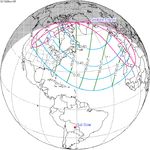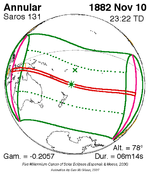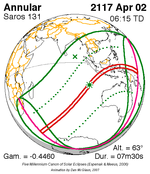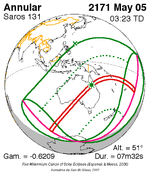An annular solar eclipse occurred on Tuesday, December 3, 1918. A solar eclipse occurs when the Moon passes between Earth and the Sun, thereby totally or partly obscuring the image of the Sun for a viewer on Earth. An annular solar eclipse occurs when the Moon's apparent diameter is smaller than the Sun's, blocking most of the Sun's light and causing the Sun to look like an annulus (ring). An annular eclipse appears as a partial eclipse over a region of the Earth thousands of kilometres wide. Annularity was visible from Chile including the capital city Santiago, Argentina including capital Buenos Aires, southern Uruguay including capital Montevideo, northeastern tip of South West Africa (today's Namibia) and southwestern Portuguese Angola (today's Angola). Aconcagua, the highest mountain outside Asia, also lies in the path of annularity.
| Solar eclipse of December 3, 1918 | |
|---|---|
| Type of eclipse | |
| Nature | Annular |
| Gamma | −0.2387 |
| Magnitude | 0.9383 |
| Maximum eclipse | |
| Duration | 426 s (7 min 6 s) |
| Coordinates | 36°06′S 53°42′W / 36.1°S 53.7°W |
| Max. width of band | 236 km (147 mi) |
| Times (UTC) | |
| Greatest eclipse | 15:22:02 |
| References | |
| Saros | 131 (45 of 70) |
| Catalog # (SE5000) | 9325 |
Related eclipses
Solar eclipses of 1916–1920
This eclipse is a member of a semester series. An eclipse in a semester series of solar eclipses repeats approximately every 177 days and 4 hours (a semester) at alternating nodes of the Moon's orbit.[1]
| Solar eclipse series sets from 1916 to 1920 | ||||
|---|---|---|---|---|
| Ascending node | Descending node | |||
| 111 | December 24, 1916 Partial | 116 | June 19, 1917 Partial | |
| 121 | December 14, 1917 Annular | 126 | June 8, 1918 Total | |
| 131 | December 3, 1918 Annular | 136 | May 29, 1919 Total | |
| 141 | November 22, 1919 Annular | 146 | May 18, 1920 Partial | |
| 151 | November 10, 1920 Partial | |||
Saros 131
It is a part of Saros cycle 131, repeating every 18 years, 11 days, containing 70 events. The series started with partial solar eclipse on August 1, 1125. It contains total eclipses from March 27, 1522 through May 30, 1612 and hybrid eclipses from June 10, 1630 through July 24, 1702, and annular eclipses from August 4, 1720 through June 18, 2243. The series ends at member 70 as a partial eclipse on September 2, 2369. The longest duration of totality was only 58 seconds on May 30, 1612. All eclipses in this series occurs at the Moon’s ascending node.
| Series members 33–70 occur between 1702 and 2369 | ||
|---|---|---|
| 33 | 34 | 35 |
 July 24, 1702 |  August 4, 1720 |  August 15, 1738 |
| 36 | 37 | 38 |
 August 25, 1756 |  September 6, 1774 |  September 16, 1792 |
| 39 | 40 | 41 |
 September 28, 1810 |  October 9, 1828 |  October 20, 1846 |
| 42 | 43 | 44 |
 October 30, 1864 |  November 10, 1882 |  November 22, 1900 |
| 45 | 46 | 47 |
 December 3, 1918 |  December 13, 1936 |  December 25, 1954 |
| 48 | 49 | 50 |
 January 4, 1973 |  January 15, 1991 |  January 26, 2009 |
| 51 | 52 | 53 |
 February 6, 2027 |  February 16, 2045 |  February 28, 2063 |
| 54 | 55 | 56 |
 March 10, 2081 |  March 21, 2099 |  April 2, 2117 |
| 57 | 58 | 59 |
 April 13, 2135 |  April 23, 2153 |  May 5, 2171 |
| 60 | 61 | 62 |
 May 15, 2189 |  May 27, 2207 |  June 6, 2225 |
| 63 | 64 | 65 |
 June 18, 2243 |  June 28, 2261 |  July 9, 2279 |
| 66 | 67 | 68 |
 July 20, 2297 |  August 1, 2315 |  August 11, 2333 |
| 69 | 70 | |
 August 22, 2351 |  September 2, 2369 | |
Notes
References
- Earth visibility chart and eclipse statistics Eclipse Predictions by Fred Espenak, NASA/GSFC
